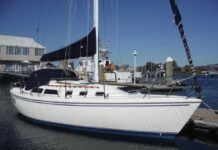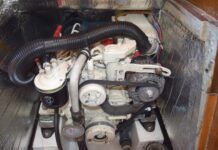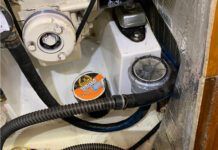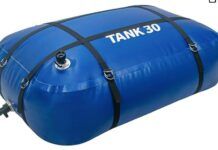You don’t need to spend a bundle of cash to get a first-class handheld VHF radio. In this, our second VHF review of 2006, well show that a C-note might be all it takes.
Dropping down a notch in price from the more expensive radios in our previous test (published July 2006) doesn’t necessarily mean sacrificing the quality, performance, functions, or features we believe are most important. In our testing, most of these radios performed as well as those in the more expensive group in all categories.
So what do you lose by opting for a less-expensive radio? Bells and whistles. If DSC calling (only two units in our expensive radio test had this feature), scramblers, or the ability to make and receive calls on multiple bands are the special features you are looking for, then the radios in this test wont cut it. But if all you want is a quality handheld to serve as a backup to your fixed-mount radio, then the best of this group will serve you just fine.
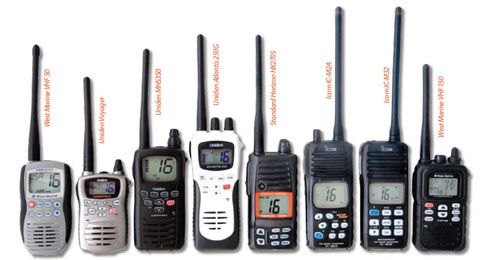
Testers turn on, tune in
We put eight handheld VHF radios through their paces.
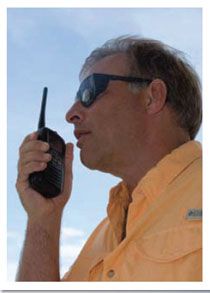
To test the VHFs, batteries were fully charged using the associated AC charger. testers ran each radio through a series of bench tests using a Ramsey COM3010 communications service monitor, and recorded the results for transmitter power output, frequency accuracy and stability, and receiver sensitivity.
Maximum power output on the portable handheld marine radios in this test was limited to 5 watts. A low-power setting-1 watt-for harbor use is also available on all radios. In addition to the high- and low-power settings, a few of the radios had a mid-power setting. We tested only at the 5-watt and 1-watt settings. We took transmitter power measurements directly off the radio antenna port located on the top of each radio.
Transmitting
Frequency accuracy is defined as the ability of the transmitter to send signals out on the selected frequency. Frequency stability measures the transmitters ability to maintain frequency accuracy over its entire temperature operating range. regulations mandate an accuracy of 10 parts per million, while industry groups typically call for half that error. This equates to being about 1550 hertz (Hz) off frequency in the marine band.
A transmitter test was done on each radio, on channel 16, first at room temperature (75 degrees F) and then at tem-perature extremes near the minimum and maximum temperature capability of each radio. to reach the cold extreme, radios were placed in a bait freezer for four hours prior to testing. the freezer was held at a temperature of 15 degrees. We used a fish smoker as an environmental chamber to get the radios to the high-temperature extreme. radios were left to cook for two hours at 122 degrees and then immediately run through another transmitter-power and frequency test.
We also checked each units low-power setting, measuring both power output and frequency accuracy. transmitter power output and frequency stability were rated over the entire range of transmitter testing; the closer a unit held to the appropriate frequency and the more consistent its power output, the higher it was rated.
Receiving
Receiver sensitivity is the ability of the radios receiver section to hear a weak signal. typical marine VHF receiver sensitivity ratings run from .22 to .35 microvolts, with industry groups recommending a minimum of .50 microvolts. All the radios rated Good or better, meaning they are more than sensitive enough to pick up very weak incoming signals.
Another receiver standard is selectivity; it is the ability of the receiver to reproduce only the signals you want to hear and not others, even though they may be strong and nearby. our test equipment did not allow us to test each radio for this characteristic. each manufacturer provided information, which is listed in the accompanying chart under selectivity; a higher number is better.
Display
Display ratings were based on the size of the channel number display, the amount of other information shown, the value of the channel comments, the size of the screen, and the quality of the backlighting.
Audio
To rate the audio system of each radio, we measured the sound pressure at maximum volume while generating a 1 KHz tone with our COM3010 and inputting the tone into the radio. Measurements were taken at a distance of 1 foot using a Radio Shack decibel meter. our tester also rated each system with a voice input by monitoring a weather channel and rating the reproductions sound quality.
Durability
A submersion test was conducted on each radio to confirm it as waterproof. the tester turned on the radios and submerged them in a bucket of fresh water for 30 minutes. After removal, he checked the radio for proper operation immediately and then again the next day. All passed.
Since these radios are frequently taken on and off the boat, we elected to perform a drop test to confirm radio durability. each radio was turned on, and then dropped from a height of 4 feet onto concrete. All passed.
Battery Life
The clock started ticking for the battery-life test immediately following charging. We allotted the first hour of battery use to run our bench tests. radios were off during their time in the environmental chambers and then turned back on a couple of days later and allowed to run continuously for the following 14 hours. We accomplished full power transmissions for about three minutes every hour and voice reception for about five min-utes every hour until the battery died or the unit began to malfunction. total battery test time was 15 hours. radios still fully functional at that time were rated at 15-plus hours of battery life. In the final analysis, we considered performance, cost (initial and battery replacement), warranty (both unit and battery), battery life, included equipment, recharge time, display, and battery), battery life, and audio output.
WHAT WE TESTED
The radios PS tested range from $100 to $175. The lineup includes two units from Icom (IC-M32 and IC-M2A), three from Uniden (Atlantis 250G, MHS350, and Voy-ager), two from West Marine (VHF 50 and VHF 150), and the HX270S from Standard Horizon.
ICOM IC-M32
The IC-M32 is one of the larger radios in our test group, but it is relatively light at 12.7 ounces. It has front-panel pushbutton control for volume, squelch, channel selection, scan, and other important functions, while making use of a top-mounted on/off switch. No provision is made to accommodate an external microphone or speaker.
Overall, the Icom IC-M32 performed respectably, scoring mostly Good or Excellent ratings. The one Fair rating it did get was on transmitter power and frequency stability. At temperature extremes, especially at warm temperatures, it tended to drift slightly off frequency, not enough to adversely affect performance, but enough to lower its rating. The IC-M32s battery didnt meet our expectations; it lasted a meager six hours. A replacement battery costs $39.
Bottom Line: The short battery life of this radio holds it back.
ICOM IC-M2A
The IC-M2A is similar in size and appearance to the less-expensive IC-M32. Upgrades to this radio include a top-mounted turn knob for on/off/volume control and a larger display screen. Additional radio functions are controlled by eight front-panel pushbuttons. Again, no provision is made for an external microphone or speaker.
The Icom IC-M2A performed well, earning two Excellent ratings and one Good rating.
The audio system performed well, too. It did, however, get a Fair rating for transmitter power and frequency stability. It was slightly off frequency in all test-ing but worse at temperature ex-tremes. It was never far enough off the mark to adversely affect per-formance, but it was off enough to lower its rating. The battery lasted only six hours. Battery replacement is $39.
Bottom Line: Again, the short battery life is a significant drawback, in our opinion.
STANDARD HORIZON HX270S
Size-wise, the HX270S is in the middle of the field. It has a single, top-mounted turn knob for on/off/volume. A side-mounted pushbutton selects the squelch function. Then to increase or decrease the squelch level, you must use the front panel up/down pushbuttons. The other six front-mounted pushbuttons control transmitter power selection, channel changing, weather, and scanning. There is no outlet for an external microphone or speaker.
The HX270S had one of the more powerful audio systems. It earned an Excellent rating for transmitter power, and it was the only radio to score an Excellent for frequency stability. Battery life didnt live up to the manufacturers claim of 18 hours, but the radio did perform well, lasting 13 hours. In this group of inexpensive handheld radios, the HX270S battery replacement cost is rather high at $65.
Bottom Line: A top performer now being marketed at a very low price-$100.
UNIDEN MHS350
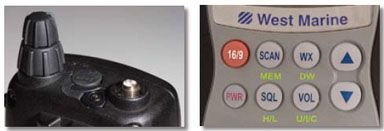
The MHS350s top-mounted volume and squelch control knobs are lo-cated next to a jack to connect an ex-ternal speaker or microphone. Eight front-mounted pushbuttons control transmitter power selection, channel changing, weather, and scanning.
The MHS350 performed well, earning all Good and Excellent rat-ings. Like all the Uniden radios, the MHS350 battery area is not sealed to prevent water intrusion. Instead, gasketing is used around the critical battery-to-radio electrical connec-tions. If this radio accidentally finds its way into salt water, it would be best to remove the battery, rinse with fresh water, and then dry everything to prevent any corrosion.
This was the only radio in our test equipped with two batteries. The accompanying quick charger brings both batteries up to full charge in four hours. Having the second charged battery readily available allows an immediate swap out of a weak or dead battery, effectively doubling the battery life of this radio. In our test, a single battery in the MHS350 lasted 11 hours. Battery replacement cost is fairly inexpensive: $29.
Bottom Line: With its good overall performance, low battery replace-ment cost, and two standard batter-ies, the Uniden MHS350 is our Best Choice.
UNIDEN ATLANTIS 250G
The Atlantis is the largest, heaviest, and ties the Standard Horizon as the least expensive handheld in our test group. It features a pair of top-mounted control knobs, one for on/off/volume and the other for squelch. A jack to connect an external speaker or microphone is also located on top. Eight front-panel pushbuttons control the other functions.
Overall, the Atlantis performed decently. It earned mostly Good ratings and racked up the highest audio-output score. Its one Fair rating was on transmitter power and frequency stability. At temperature extremes, it tended to drift off frequency ever so slightly, not enough to affect performance, but enough to lower its rating. One of the last radios operating in our battery-life test, the Uniden Atlantis survived 14 hours (two hours short of the makers claim). A replacement battery for the Atlantis costs $39.
Bottom Line: The Uniden Atlantis, priced at $100, has nice controls and performed well.
UNIDEN VOYAGER
This is the smallest unit in the group, and only the West Marine VHF 50 is lighter. Despite its diminutiveness, theres enough room on the top for on/off/volume and squelch rotary knob controls and a jack to accommodate an external speaker or microphone. Eight front-panel pushbuttons control the remaining functions including channel selection, scan, and transmitter power output.
The Voyager performed well in our tests, earning all Good ratings. Battery life on this radio was tested at nine hours, just above the manufacturers eight-hour claim, but significantly less than most of the other radios. Battery replacement is $43.
Bottom Line: The compact Voyager performed well, but even though it exceeded the manufacturers battery life claim, it still has a shorter battery life than the best. Its pricey, too.
WEST MARINE VHF 50
Eight pushbuttons on the front of the VHF 50 control all functions. We prefer having the more user-friendly rotary knob for control, especially for volume and squelch. West Marine Product Manager Chuck Haw-ley said boaters are more likely to set the squelch incorrectly with a rotary knob and have it blasting static. Having a push-button control on the VHF 50 is no disadvantage.
There is no outlet for an external microphone or speaker on this radio. Testers found the side-mounted push-to-talk switch hard to hold down when transmitting for more than a few seconds.
Overall, performance of the VHF 50 was above average. Highlights included Good transceiver rating, an Excellent display rating, and the longest tested battery life. This one was still going strong at 15 hours. The West Marine VHF 50 was the only radio to earn a Fair for audio quality. Hawley said the VHF 50 will be replaced with the VHF 55, which will have better waterproofing and an improved battery.
Bottom Line: Lack of any turn knob controls and a sub-par audio system hold back this radio.
WEST MARINE MHF 150
Nearly the same size as its little brother, but several ounces heavier, the more expensive VHF 150 is housed in a well-armored, die-cast metal case. On/off/volume and squelch knobs are mounted on a concentric shaft on top of the ra-dio. A top-mounted adapter ready to accept an optional speaker or microphone is on top, too. Eight front-panel pushbuttons control the remaining functions. On the side are an easy-to-operate, push-to-talk switch and a backlit on-off switch.
Overall, the West Marine VHF 150 had middle-of-the-road perfor-mance. It had a highly rated display, but the transmitter tended to drift off frequency slightly at temperature extremes, not enough to adversely affect performance, but enough to earn only a Fair rating for transmitter power and frequency stability. We also found the audio system to be weaker than the other radios. In the battery-life test, the VHF 150 lasted 13 hours, just beyond its 12-hour claim. At $70, battery replacement cost is the highest in the test group.
Bottom Line: A neat-looking compact radio with a weak audio system.
CONCLUSIONS
All of the radios are waterproof, have side-mounted push-to-talk switches, display and pushbutton backlighting, and three-year warranties. They operate on the Marine Band only, and include an A/C charger. Whats different among these radios? Battery size, life, and cost, plus the con-trol layout. We preferred the radios with all-around good performance, better-than-average battery life, and superior controls.
The Uniden MHS350 is our top pick, with its concentrically mounted volume and squelch knobs, large display screen, extra battery, and good performance. The Standard Horizon HX270S garnered our Best Buy rating with excellent overall performance and a bargain basement price.
ICOM
425/454-7619
icomamerica.com
STANDARD HORIZON
714/827-7600
standardhorizon.com
UNIDEN
800/297-1023
uniden.com
WEST MARINE
800/262-8464
westmarine.com





